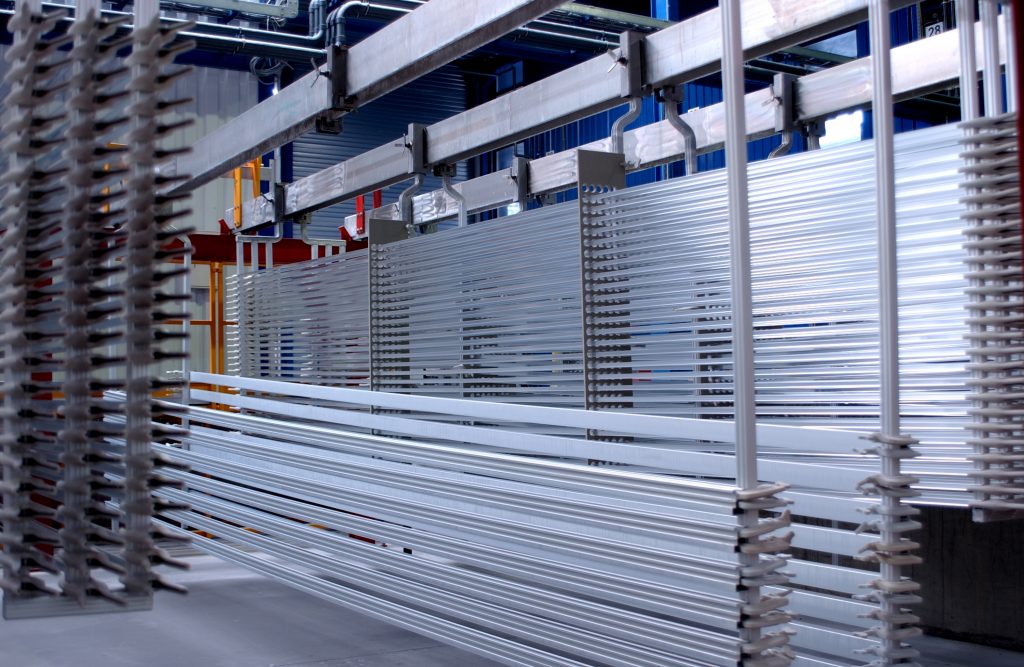A small aluminium pyramid about 22 cm high was mounted on the Washington Monument in the USA as early as 1884 as an aesthetic lightning rod. It is hard to believe that at that time aluminium, which was still rare, was more expensive than silver. This aluminium spike is also considered the first known use of aluminium in construction in America and can be admired there at a height of about 170 metres. Nowadays, you don’t have to climb to a height of 170 m to discover aluminium in construction. Aluminium can be found in window construction, for example, where it has been considered a particularly solid, resistant and thus reliable material for decades. However, before the final product is finished by the window manufacturer, it requires numerous mechanical and chemical process steps beforehand. In this article, we will look at the chemical pre-treatment required for anodising.
The first question to be answered is what the window should look like later. The answer then defines the necessary pre-treatment process. A distinction is made between two main directions in chemical pre-treatment -the anodisation and the coating (e.g. with powder coating). The advantage of anodising is that the typical metallic character of the aluminium is also retained in the final product. At the same time, an artificially create doxide layer (aluminium oxide) of at least 15 μm thickness is applied, which serves as a protective layer and can also absorb colour. If the aluminium profiles are mechanically processed beforehand (grinding, brushing, polishing…), particularly decorative and structured surfaces can be achieved.

If only mechanically pre-treated aluminium surfaces were used in window construction, the window would look unsightly quite quickly. However, the aluminium metal is always covered with a natural oxide layer a few nanometres thick, which prevents rusting through as with iron. Only the subsequent chemical pre-treatment then enables the desired long-term protection while retaining the decorative surface. It then remains to be clarified whether the window should later remain natural-coloured (silvery) or whether a colouring is desired. At this point, however, the anodising process reaches its limits, as the choice of colours is limited (e.g. bronze, black, gold and grey shades). There are further developments such as copper shades, as well as earth and wood colours (Terra-ColorAL -process, Alufinish). All these colouring processes show a particularly high light resistance when the anodised layer is coloured with them. Theoretically, one could also use coloured, organic dipping dyes, but these often fail due to their lower light and weather resistance. An exception to this is the Sandalor® process, which is a combination of electrolytical dyeing and certain organic dyes. This process is also used in the architectural sector and offers further colour options.
What chemical pre-treatment steps are required for anodising?
- cleaning
As the name suggests, this involves the removal of oils, greases, dust and residues from the mechanical processing of the window profiles. Mildly alkaline, aqueous degreasing products(e.g. Alficlean 152) are usually used for this purpose. - rinsing
- decorative pickling
In accordance with the specifications of DIN 17611 and the surface designation E6, an alkaline long-term pickling is used for the decorative mat finishing of the aluminium. The degree of mat finishing can be influenced by the choice of bath parameters, depending on how the window is to look later. During the mat finishing process -e.g. with the additive Alfisatin 339/4 -aluminium is removed, thus concealing existing surface imperfections (such as extruding marks) and removing remaining natural oxide residues from the aluminium. This step is decisive for the later appearance of the window profiles. Less frequently, chemical polishing processes are also used if a certain degree of gloss is to be achieved instead. - rinsing
- desmutting (desoxidation)
The previously used pickling process leaves insoluble residues on the surface, which would lead to an unattractive appearance of the end product. Therefore, desmutting (sulphuric acid or nitric acid,e.g. with additives such as Alfideox 79) is used to remove these residues from the surface. - rinsing (depending on applied desmutting process)
- Anodising
During the anodising the protective layer is formed on the surface, which later protects the window from atmospheric influence. During this current-supported process in a sulphuric acid bath, a porous ceramic aluminium oxide layer is grown on the aluminium, which enables the absorption of dyes. The layer is grown both into and out of the base metal. The previously created matting during the pickling process also remains on the surface. Certain bath additives, such as Alfinox 510, can influence the hardness of the oxide layer or favour subsequent colour absorption. - rinsing
- dye or not dye?
If the window is to remain natural-coloured (silvery), this step is simply skipped. Electrolytic colouring processes are often used here, in which metal pigments are then deposited in the oxide layer by means of electricity (e.g. black colouring with Alficolor 677). Alternatively, inorganic immersion dyeing (e.g. with Alficolor Gold 602) can be used, which then produces a gold colouration of the window surface. However, gold is not actually used here, but iron compounds. Other alternatives are combination and immersion processes with certain organic dyes. In this case, however, it should always be clarified what the long-term resistance of the colours looks like. - rinsing
- sealing
In the final process step, the window profiles are sealed. More precisely, the still open-pored oxide layer is sealed. This is because only a correctly performed sealing enables the long-lasting protective effect while retaining the decorative character of the later window. This process is usually carried out using classic hot sealing, i.e. with almost boiling water. For this purpose, special sealing additives such as Alfiseal 942 are added, which improve the grip resistance to fingerprints. Alternatively to this process, there are also processes that work at much lower temperatures and consist of special salt solutions. With these alternatives, an additional ageing stage (warm water) is then usually required.

Once the window profile has undergone this chemical pre-treatment, it is sufficiently protected and shows the desired optical characteristics. Now nothing stands in the way of further processing and finishing by the window manufacturer. Would you have thought that so many process steps are needed? As with washing a car, anodised window profiles only retain their beautiful appearance if they are cleaned regularly. The special cleaning paste Alupolish is ideal for this purpose, as it refreshes old aluminium oxide layers and preserves them at the same time.

Do you have further questions about chemical pre-treatment? Then please feel free to contact us.
